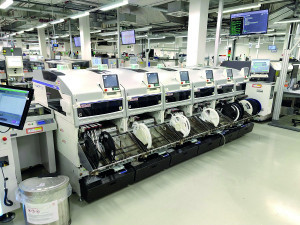Sensor manufacturer ifm has implemented a condition-based maintenance concept for the placement heads in the SMD production of assemblies for its IO-Link sensors. The placement machines come from Fuji. The basis of the maintenance concept is the shop-floor integration of GIB.
At its plant in Tettnang, ifm electronic gmbh produces intelligent sensors with an IO-Link interface, which are predestined for requirements in the networked factory in accordance with the Industry 4.0 concept. The sensors are characterized by the fact that they transmit the measured values digitally and therefore without interference. They also provide additional information to higher-level systems, which can be used for predictive maintenance, for example. They can be used in a variety of ways in production plants and are easy to put into operation.
The ifm group of companies has around 8100 employees worldwide and serves sectors such as the automotive, food and packaging industries with its sensor and industrial electronics solutions. Its customer base also includes machine tool manufacturers.
14 scalable placement platforms from the Fuji NXT III series are used to manufacture the electronic assemblies for the IO-Link sensors. They not only support the positioning of the smallest parts, as used in ifm production, but are also suitable for condition-based maintenance. This is implemented by ifm using store floor integration from the software manufacturer GIB, which is based on real data and records the individual wear and tear of tools.
Condition-based maintenance avoids over-maintenance
 Assembly machines in the ifm production facility in TettnangThe most importantelement of an IO-Link sensor is a circuit board that enables communication. Stefan Gessler, Head of Maintenance at ifm: "We use SMD placement machines from Fuji to manufacture these IO-Link boards. We have 14 modules from the NXT III series in use in our production. The placement heads can be replaced easily and without tools. This allows us to carry out offline maintenance without interrupting ongoing production."
Assembly machines in the ifm production facility in TettnangThe most importantelement of an IO-Link sensor is a circuit board that enables communication. Stefan Gessler, Head of Maintenance at ifm: "We use SMD placement machines from Fuji to manufacture these IO-Link boards. We have 14 modules from the NXT III series in use in our production. The placement heads can be replaced easily and without tools. This allows us to carry out offline maintenance without interrupting ongoing production."
The placement machines therefore form the basis for the condition-based maintenance of the placement heads introduced at ifm. This was realized through shop-floor integration. The sensor system in the machine measures the placement cycles of the respective head and automatically forwards the data to the ERP system. When the maximum number of picks per placement head is reached, the system automatically creates a maintenance order and initiates the spare parts reservation. ifm can therefore carry out more efficient and plannable maintenance and servicing. Downtimes and set-up times are minimized.


